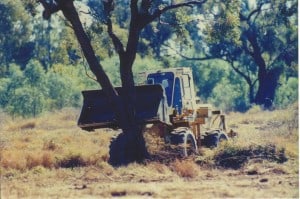By Ellen Weber
CAFNEC is alarmed by the Newman Government’s decision to wind back the State’s tree clearing laws which helps to protect our endangered animals, birds and plants, our drinking water and our biodiversity.
The rules and regulations that brought an end to the clearing and devastation of Queensland’s forests, woodlands and riparian vegetation are being torn up in changes to the Vegetation Management Act (VMA).
Before the VMA came into effect, Queensland experienced the highest rates of clearing in Australia. For example, between 300,000 to 750,000 hectares were cleared annually between 1988 and 1999. After a major campaign from conservation groups and communities throughout Queensland, new laws were brought in that led to a decline in clearing rates to 77,590ha in 2009-10[1]
CAFNEC Coordinator Anna McGuire and Alliance to Save Hinchinbrook Coordinator Margaret Moorhouse recently appeared before a Parliamentary Inquiry into proposed amendments to the VMA.
They argued that the proposals to water down tree clearing regulations in Queensland will have devastating effects on many endangered species including mahogany gliders, quolls, and cassowaries, and hundreds of other threatened species.
The amendments are also very bad news for landscape corridors and the integrity and for our long-term economic prosperity and social well-being. Land clearing will also encourages exotic and invasive plants, animals and insects to make a new home. These invasive species include weeds like lantana (Lantana camara) and the rubber vine (Cryptostegia grandiflora), which are a nightmare for farmers.
Native vegetation supports healthy landscapes which in turn provide essential ecosystem services, including protecting water quality, healthy soils and rivers and more productive agricultural systems. They provide food and shelter for thousands of species. They also make us more resilient to changing climates.
The changes to the legislation will immediately affect more than 700,000 hectares of regrowing native vegetation, including some 30-year-old woodland.
There are four major changes affecting land clearing that have been introduced by the Newman/Seeney Coalition government. The amendments to the VMA include:
- Remove restrictions on clearing of bushland that was cleared post December 31, 1989 (counts towards compliance with Kyoto Protocol) and is now regrowing
- Allow a new type of broad-scale clearing of mature bushland for ‘high value agriculture’– a term yet to be defined by the government
- Alter provisions to make it harder to enforce restrictions on illegal clearing, for example allowing the defence of ‘mistaken belief’ or that a person other than the defendant was responsible for the clearing, and
- Removal of requirement for permits to clear native vegetation in watercourses.
The amendments propose making “sustainable land use” a key purpose of the VMA, without defining what this will mean in practice, thus effectively allowing the clearing of remnant native vegetation on grounds determined by the Minister alone.
More worrying about the relaxation of these laws, is knowing that it is part of a broader strategy for the Newman/Seeney lead government to attempt to double agricultural production in northern Queensland by 2040, despite the realities of the regions natural limitations in this regard or the impact on its biodiversity and natural values.-
Please contact your local Queensland Government Member of Parliament and tell them that you are unhappy about their poor policy decision and that you want the Premier’s pre-election commitment to be kept. You can find your local member at http://www.parliament.qld.gov.au/members/current/list
[1] Department of Science, Information Technology, Innovation and the Arts. 2010. Land Cover Change in Queensland 2009-2010: Statewide Landcover and Trees Study Report, p 1. Available online:



